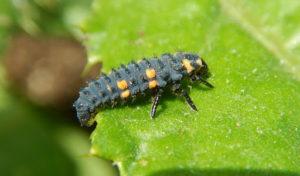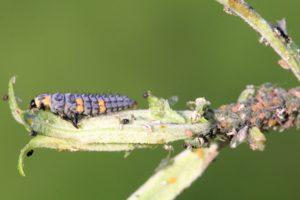Ladybug eggs and larvae - a caterpillar with a brutal appetite
Round red bugs with black dots are quite common for people, and even a small child can easily identify an adult ladybug. But, just like other insects, before turning into adults, cows go through the stage of larvae, but few people know how these larvae look and what kind of life they lead.
Content
Appearance of ladybug larvae
The body of the larvae at the beginning of development has an oblong shape and is colored gray, with a purple or blue tint. On the back of a young insect there are bright spots of yellow or orange. In the process of growing up, the color of the larvae can change and becomes brighter.
The head of the larva has the shape of a rectangle with rounded corners. On the head is a pair of antennae and three pairs of simple eyes. The mandibles of the larva may be sickle-shaped or triangular in shape. The legs of the young "cow" are very well developed, which allows them to actively move. The body length of the larva changes during maturation and can reach from 0,5 mm to 18 mm.
Unlike adult bugs, ladybug larvae cannot boast of an attractive appearance.
Stages of development of ladybug larvae
The development of the insect begins with the laying of 5-6 hundreds of eggs by the female, while the sun bugs make several ovipositions, each of which has 40-60 eggs. After 10-15 days, larvae are born, which go through several stages of development before becoming an adult.
Newborn larvae reach a length of only 2-3 mm. The predatory instinct in insects manifests itself immediately after birth. During this period, their diet consists of aphid egg-laying and young pest larvae. The body of the larva at this stage of maturation is colored dark, almost black.
After 25-30 days after birth, the larva reaches a length of 10 mm. By this time, the young insect has already accumulated enough nutrients and begins the process of pupation. The pupae of sun bugs are painted black. This stage of bug development lasts about 15 days.
10-15 days after pupation, the cocoon cracks and a fragile adult is born. After the elytra of the insect hardens, the newly minted ladybug goes in search of food.
The benefits and harms of ladybug larvae
The bulk of ladybugs living on earth are predators. This applies not only to adults, but also to insect larvae. At the same time, the larvae are distinguished by a more “brutal” appetite than adults.
They destroy a huge number of aphids and other pests, such as:
- spider mite;
- worms;
- whiteflies.
Natural enemies
It is worth noting that almost none of the animals eat the ladybug larvae themselves. Just like adult beetles, their body contains a toxic substance that makes them poisonous to such insectivores as:
- birds;
- spiders;
- lizards;
- frogs.
Conclusion
Few people know what ladybug larvae look like. They are often confused with caterpillars of garden pests and, having noticed cultivated plants on the surface, they try to get rid of them. However, the larvae of the sunbug are of great benefit and destroy even more pests than adults. Therefore, the owners of private gardens, kitchen gardens or summer cottages need to know their faithful helpers “by sight”.
Previous
